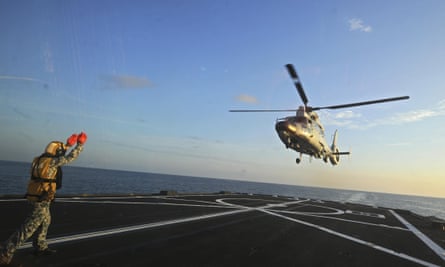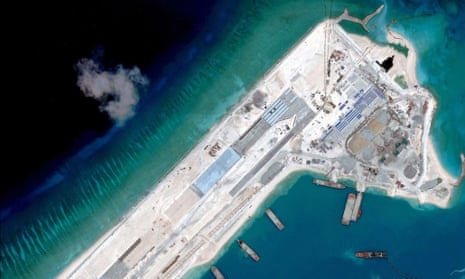What’s the story?
Over the last two years China has dramatically stepped up land reclamation work on reefs and atolls it claims in the Spratly Island chain in the South China Sea, also claimed by the Philippines, Taiwan, Malaysia, Vietnam and Brunei. Chinese ships have been dredging new harbours, while cranes have been erected in an attempt to build artificial islands atop submerged reefs. There is evidence of airstrips being built. The US has protested that the work is illegal and destabilising and for months the Pentagon has been pushing the White House to take a firmer stance.
Washington has said it will ignore any Chinese claim for territorial waters based on new man-made islands, and has flown a surveillance plane with television crews to film the dredging work, sparking bitter Chinese complaints and dark talk in the Chinese press about a coming conflict.
On Tuesday, the US upped the ante once again by deploying a warship to sail through a 12-nautical mile zone around two artificial islands in the archipelago. China responded by accusing the US of “provocative actions” – but there was no immediate sign of any military response from Beijing.
This article includes content hosted on edition.cnn.com. We ask for your permission before anything is loaded, as the provider may be using cookies and other technologies. To view this content, click 'Allow and continue'.
How did this happen?
Control over the South China Sea and its reefs has swung violently over the centuries with the rise and fall of empires, leaving the issue of ownership in the 21st century hazy at best. China’s claims on the Spratlys and the Paracel islands to the north, are based more on historic settlement rather than geographical proximity. As the regime in Beijing has built up its long-distance “blue water” navy it has become increasingly assertive, bolstering its claims with accelerating construction work, and shrugging off calls for a regional negotiation settlement on the Spratlys’ future.
The other claimant nations have maintained outposts on the reefs, but China has raised the stakes by seeking to change the geography with significant man-made islands. In May 2015, US officials claimed the Chinese had added 2,000 acres to their outposts in the previous 18 months, much of it since January.
The US has grown increasingly alarmed at Chinese maritime muscle-flexing, combined with the lack of cohesion among America’s allies in the region, and has decided to challenge Beijing’s claims more directly on water and in the air. Tuesday’s freedom of navigation operation near the Spratly archipelago represents the first such mission near territory claimed by China in the South China Sea since 2012.
What are the issues?
On one level, this is a struggle over natural resources. There are believed to be vast oil and gas fields beneath the sea bed, as well as substantial fisheries. The Spratlys and Paracels also straddle one of the world’s busiest shipping channels. It is also about what kind of world power China is going to be under its president, Xi Jinping, who has an interpretation of China’s global role that puts naval strength at the forefront. In a recently published defence policy doctrine, Beijing puts great emphasis on its burgeoning navy and its mission to “safeguard national territorial sovereignty and maritime rights and interests, and maintain security and stability along China’s periphery”.

There are legal issues, but China’s standing is weak. Other countries’ have equally strong, if not stronger, historical claims. Beijing is also ignoring the UN Convention on Law of the Sea and dodging multilateral negotiated solutions, preferring to creates “facts on the sea”. That raises the question of how far Washington is prepared to go in calling China’s bluff. Its decision earlier this year to fly over the Spratlys to film the island-building work was intended to galvanise its allies into concerted action to counter Beijing’s moves, but the states of the region are looking to the US to take the lead in flexing military muscle on their behalf. Tuesday’s naval mission indicated that Barack Obama and Xi Jinping found little common ground during recent talks about the situation in the South China Sea and that Washington now feels it is time to up the ante.
Finally, the geopolitical competition is a disaster for a delicate ecosystem of coral reefs and tropical sealife, one of the richest and most diverse in the world.
What will China do next?
It is unclear how China will respond to the US navy’s foray into what it claims as its territorial waters. Earlier in October China’s foreign ministry said it would “never allow any country to violate” its interests in the South China Sea. On Tuesday, Beijing said it had warned the US warship to leave the area and accused Washington of launching “provocative actions” in the region. However, there was little sign of a more robust military response.
Rory Medcalf, a South China Sea expert from the Australian National University, said that by deploying one of its most powerful vessels to the region, the US appeared to have called China’s bluff.
“It looks like Chinese forces have not been given the authority to make that kind of challenge so this will play quite badly for China’s self-made reputation as being determined to face off any American presence,” he said.
Medcalf said Xi’s most sensible move now would be to downplay the significance of the US mission in China’s domestic media. “The more dangerous thing for him would be to express public outrage at the unacceptable US behaviour because that would oblige him to take … some kind of retaliatory action.”
China’s initial reaction – angry in style but muted in content – appeared to suggest it would follow that advice.
How can I find out more?
Some of the most detailed discussion of the South China Sea can be found on the South Sea Conversations website, run by Andrew Chubb an Australian academic. The South China Sea website has a comprehensive set of maps of the conflicting territorial claims. This BBC summary has a concise timeline of events and a useful map of the UNCLOS-based division of the Spratlys, compared with the extent of Chinese territorial claims. The European Union Institute for Security Studies produced this issue brief last year on the ecological consequences for the South China Sea.
